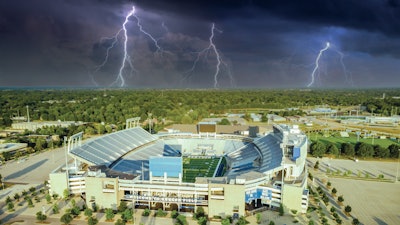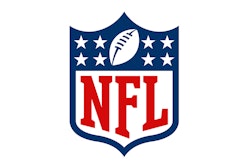
Ashley Moberg saw a flash of light and heard a giant boom. Her 74-year-old father, John, lay unconscious on the parking lot pavement outside Tampa’s Raymond James Stadium. With her ears ringing, 19-year-old Ashley thought her dad was dead and that she was dying.
John had been launched face first to the ground, breaking his cheekbone. Ashley had been shot right out of her shoes, the rubber soles of which likely saved her life, according to first responders. The Mobergs were lucky to survive the lightning that struck as they departed nearby George M. Steinbrenner Field, where moments earlier a storm had ended an April 2 spring training game between the New York Yankees and Atlanta Braves in the sixth inning.
Injury caused by lightning has become a relatively rare occurrence in the United States, and fatal lightning strikes are rarer still. Deaths caused by lightning during sports or recreation activities (not including fishing on or near open water) have become next to nonexistent in recent years.
According to data gathered by the National Weather Service and analyzed by AB, just five of the 191 known lightning-related deaths in an eight-year period spanning 2013 to 2020 (the most recent year for which detailed data is available) involved the outdoor activities of playing soccer (1 fatality), golf (2), disc golf in a park (1) and volleyball on a beach (1).
Compare that to the five-year period from 2008 through 2012, when 28 of 241 known fatalities occurred during sports- or recreation-related activity: watching, playing or coaching soccer (12 fatalities); golfing (8); playing baseball or softball (3); and running on a track or participating in a track meet (2). The remaining deaths involved individuals attending football practice, evacuating a water park pool and seeking cover under a tree in a park.
One reason for the drop-off in deaths is that the sports and recreation industries have gotten better at warning participants of potential lightning threats, thanks in large part to an expanding marketplace of lightning detection technology providers.
“I think over the years to have more entities out there advocating for the use of lightning warning systems in general kind of validates everybody’s position,” says Christoph Zimmermann, owner and general manager of Wxline LLC in Tuscon, Ariz., founded in 2001. “It’s actually helped us as a company.”
The ultimate beneficiaries are those spared the catastrophic impact of severe weather, according to Bob Dugan, president of Thor Guard in Sunrise, Fla., which has been in the business of analyzing atmospheric conditions suitable for lighting strikes since 1973. “Sports participants are among the best protected,” Dugan says, “because an increasing number of sports organizations have made the investment.”
Making the call
Valerie Sanders is a meteorologist and co-founder of WeatherCall Services LLC in Tulsa, Okla. — strategically positioned within America’s so-called “tornado alley.”
The company has evolved since its 2007 inception to where it now contracts with two weather data centers separated — by design — by more than 1,000 miles but mirroring each other in the event one goes down. Those communicate with 16 contracted servers in the field that process phone messaging to WeatherCall subscribers in the event any given client’s longitudinal and latitudinal coordinates fall within a storm warning area (the weather-service-produced polygon defined by its own coordinates at each corner). “We’re comparing every single warning polygon the weather service draws to the lat-longs of our users in our database in real time. If any of our clients are inside of that red box, we send them the warning,” Sanders says. “We put a latitude-longitude on that record out to seven decimal points, so we know where they are right down to the city block.”
In addition to accuracy, time is of the essence. “We can process 500 phone calls simultaneously in about 30 seconds and then reload the next batch of 500,” Sanders says. “We’ve got 16 of those servers going simultaneously. That’s 8,000 simultaneous calls that we can push about every 45 seconds. The capacity is big.”
Sanders points out that the weather service will provide about a mile of wiggle room on either side of a storm’s path when drawing its warning polygon, and then the service fans the polygon wider the farther down the projected path it goes, accounting for a storm’s unpredictability as it travels (typically west to east in the northern hemisphere).
Meanwhile, WeatherCall pads the location of its school subscribers with a one-mile buffer in all directions. “Any time any one of those polygons intersects that one-mile virtual radius, we start pushing the warnings proactively out to the school — whomever the school has populated in the roster as the contacts who need to know that they’re under a storm warning,” she says. “We’re pushing out tornado warnings, severe thunderstorm warnings, and also lightning within either six or 10 miles. They get to choose which distance.
“Say, at six miles, the first strike intersects, we start pushing out warnings by email, phone and text, with a graphic that shows where it is. Then, as the storm moves across that six-mile bubble that we have around them, they can choose either a 15-minute wait period or a 30-minute wait period.”
WeatherCall as a company hasn’t remained static, either. Two new product offerings include one designed to warn vehicles such as school buses and team charter buses and vans of pending weather-related danger. WeatherCall’s system tracks the vehicle, not an onboard subscriber phone (the operating system of which may limit how many times apps can ping the phone’s GPS chip in the interest of battery preservation). “When it’s in travel mode, it is sending its coordinates once every five minutes into our servers,” Sanders says. “So we can match you up in real time with weather that you don’t need to be anywhere near.”
The other product is a warning system of sirens and lights for given locations, still relying on the call system and coordinates, but adaptable to different seasonal needs. “You register the location of it,” Sanders says. “Let’s say a school wants to put it on the football fields in the fall and the baseball fields in the spring, and they’re a quarter-mile apart. They can literally move it over to the ball fields, log into their account and tweak it, so it’s super accurate. If they want to move it to another campus, they can pick it up and move it, but they have to register the new address in the system so the system knows where it’s monitoring.”
Removing the human element
Onsite detection and warning is the space Wxline chooses to occupy.
“First of all, it puts more control, I think, in the hands of the user to have your own equipment local at your facility,” Zimmermann says. “And more importantly than that even is you’re dealing with a life-safety, critical piece of equipment with sirens and lights that go off automatically once the lightning threat has been determined to have occurred. In order to do that reliably, having a local system that doesn’t rely on a lot of infrastructure such as personal computers, the internet, cellphones and commercial power really makes sure that that warning is issued with your local system. When does infrastructure generally go down? It’s really during local storms. If you’ve got a thunderstorm right on top of your facility, this is when you run the risk of these things going down or not working properly.”
The Wxline system operates on long-life battery and rechargeable battery power. “We’ve always built our system to work in a lightning environment,” Zimmermann says. “It’s designed to work even during the harshest conditions.”
It encompasses two components: detection and notification, which involves horns, stacked lights or strobes, in any combination, with a siren station that can cover a roughly 800-yard radius, or multiple soccer fields. End-users can choose a five- or 10-mile radius for lightning detection, based on such factors as the size of the facility and its access or proximity to suitable shelter.
Phone notification also is possible. “We can send an email notification out or we can send the data out to your phone, but what we can’t control is the cellphone company actually delivering that message onto your device, whereas we can control our own radio signal that’s generated at your location that activates those siren stations and strobes,” Zimmermann says.
“One of the desires that most people have when they buy a system is really to remove the human element from the decision-making process. Having a siren go off is an unemotional thing, right? The detector doesn’t care that you’re in the bottom of the eighth inning, or that you have only six more minutes left to play in a game. ‘We can finish this off. We don’t want to reschedule.’ I’m prone to it, too. It’s different to have this object issuing a warning compared to a parent or coach who pulls out a cellphone in response to an alarm sound and yells to everybody. A siren is going to go off when there’s a threat. And when it goes off, there’s no question, and everybody just responds to it, even if it’s inconvenient.”
Mining data for new clues
Thor Guard lays claim to being the first and only system that not only detects lightning, but can predict lightning-favorable conditions before a first strike occurs based on electricity in the immediate atmosphere.
According to Dugan, technology is catching up to what the company has wanted to do for decades, namely warn about all manner of weather events — from tornadic activity to dangerous heat.
At an LPGA event in 1993, Dugan noticed unusual readings from a Thor Guard unit, which up to that point had been designed to focus primarily on lightning. “I think we’re going to have a serious wind event,” he said in the moment. Tents were cleared, and 18 minutes later, a tornado passed a quarter-mile north of the golf course. “The tents were all gone,” Dugan says. “Nobody got hurt, and the weather service never even issued a watch. So that taught me that a tornado is an electrical event just like lightning. Electrical energy was being created by that tornado.”
At the time, Thor Guard wasn’t advanced enough to give Dugan sufficient archived data to really spell out what he had experienced that day. That has changed. “Our older system would sample the atmosphere 50 times a second, which is a lot,” he says. “The new system is doing it 150,000 to 170,000 times a second. The data we’re getting now is nano data. And we did not think we could learn anything from that much data, but we have. We archive all of the electrical information that we’re seeing. Everything. What it has allowed us to do is to really enhance our prediction capabilities.”
Those capabilities now include tornado prediction, according to Dugan. “We’ve provided three tornado warnings, and we’ve had three tornadoes,” he says. “Two of them were more or less in line with the weather service, but the first one was at Minnesota’s National Sports Center. We had given them a severe storm warning, which comes before the tornado — before they even knew they were getting weather, because the radar showed everything 20, 30 miles to their north and not affecting them at all. Then all of a sudden, the back end of it just dropped the line straight down. It came in the evening after the sun had gone down and play had stopped. However, the director was watching hockey inside the field house on the property, and his phone went off. It was the weather service notification of a tornado watch. So, then he went back and he looked at what his Thor Guard was doing, and it was already in a high warning. The tornado actually landed just past them. They didn’t get any damage, but it went right over their head.”
When asked why the same weather services that seem to be getting outsmarted by Thor Guard don’t employ its technology in the first place, Dugan points out that the company will be presenting for the first time at the Meteorological Technology World Expo in Chicago this August.
It’s that time of year when football practice brings renewed focus on heat illness, another risk Thor Guard hopes to mitigate for its end-users. “As part of our algorithm on our weather sensor, we obviously look at humidity, temperature and solar radiation, which is very important,” he says. “We have something in the system called the evapotranspiration rate. If you’re a golf course superintendent, it tells you the amount of moisture being drawn from the leaves of a plant to tell you when you need to water or not water, but that also creates the same kind of dehydration in people.”
Shutting down sports in Florida, where the heat index can be high from 11 a.m. to 6 p.m. on most days, is not an option. “What you can do is teach people the powerful use of water or other fluids that can replace the fluids they lose,” Dugan says. “The only NFL team right now that has a new system, and this part of it, is the Miami Dolphins. They will learn it as we get into the heat part of the season, and I’m sure that we’ll be down there formulating stuff for them.”
Thor Guard is also in the process of assembling networks among its installations. “Southwest Florida, we’re working on it right now. We have 16 or 18 of the new systems here alone,” Dugan says. “Users can go to a map and see what all of the Thor Guards in their area are doing live. They can click on a particular Thor Guard, which gives them the lightning information, live radar and weather information at that site.”
Given the availability of technology — and its apparent recent track record of success in keeping individuals safe from lightning and other weather-related risks — doing nothing is no longer an option for facility operators who wish to avoid catastrophe and the potential liability that comes with it.
Says Zimmermann, “If you’re an operator for an outdoor facility, you kind of recognize that at some point, lightning is going to become a threat to you, and you have to decide, ‘What am I going to do to address lightning when it comes?’ You don’t want to act like it’s the first time you’ve ever been exposed to lightning when a storm comes through and everybody scrambles and the staff doesn’t know what to do. It’s a really, really good idea to have a plan, even if you don’t have detection equipment. The idea of having a play-at-your-own-risk policy to somehow remove the responsibility to keep people safe has really been proven not to hold up. The courts oftentimes apply the standard of, ‘What would a reasonable person do?’ Is it reasonable for you to operate an outdoor facility where you have people exposed to the weather and not have a means to warn them when there’s lightning? That’s not reasonable.
“Lightning is a foreseeable event. It is an act of God, but it is foreseeable.”





































